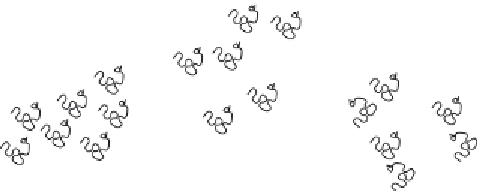Biology Reference
In-Depth Information
(a)
(b)
(c)
(d)
Figure 4.5
Schematic of flocculation process by polymers. Source:
From Figure 8 from
Ref.
96
. Reprinted with permission.
The use of nonmetal coagulants has been attracting increasing atten-
tion over the last few years. Polymers and natural compounds have
been the main focus of attention, and a schematic of the process of
polymer flocculation is shown in
Fig. 4.5
. One example is the natural
compound extracted from the
Opuntia ficus-indica
cactus as a floccula-
tion and concentration agent for bacteria suspended in water.
46
Another
example, presented in 2012, is the use of
Moringa oleifera
seeds to floc-
culate
Giardia
and
Cryptosporidium
, although the focus of the study
was water treatment.
47
Alternatively, the reader is referred to the 2009
review by Renault et al. for more information on the uses of chitosan
as a coagulant.
48
Polysaccharide polymers of microbial origin offer a unique and interest-
ing class due to their structural plasticity, stability, and functionality. More-
over, by using metabolic engineering, the turnover of such extracellular
polymers from producer bacterial strains may be increased significantly.
Ghosh and co-workers have applied such polymers for the flocculation of
bacteria
49
and protozoan pathogens.
50,51
4.3.5. Filtration specific for parasites
Concentration and detection of
Cryptosporidium
oocysts and
Giardia
cysts
are standardized and described in for example “ISO 15553 Water quality—
Isolation and identification of
Cryptosporidium
and
Giardia
cysts from water”























Search WWH ::

Custom Search